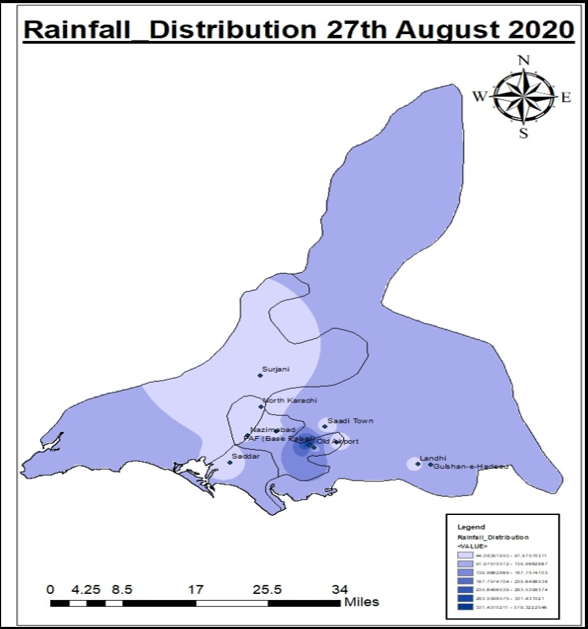Climate Change and the Changing Rainfall Patterns in Karachi
Keywords:
Climate Change, Monsoon, Precipitation Pattern, Karachi, Statistical Analysis, GISAbstract
Abrupt weather phenomena, including heat waves, frequent intense storms, outbreaks of forest fires, glacier melting, and flash floods are experienced throughout the world. Pakistan lies in the South Asian region that falls in the monsoon climatic regime, experiencing summer rainfall. The city of Karachi, which is also highly urbanized situated in southern Sindh and receives secondary monsoon rainfall from the month of July to September. During the 1960s, the city received appreciable rainfall during the monsoon, but the amount of rainfall started declining during the 1980s. At the end of the 20th century, the rainfall pattern was quite abrupt, associated especially with the passage of cyclones, which developed in the Arabian Sea and, after touching Oman, reached Karachi, or, moving from Gujrat in India, reached Karachi. So, the rainfall which received annually is now received within a day. The study represents the statistical analysis as well as the GIS and remote sensing perspective of the changing patterns over the last fifty years.
References
H. W. Muhammad Adnan, Baohua Xiao, Shaheen Bibi, Peiwen Xiao, Peng Zhao, “Addressing current climate issues in Pakistan: An opportunity for a sustainable future,” Environ. Challenges, vol. 15, p. 100887, 2024, doi: https://doi.org/10.1016/j.envc.2024.100887.
H. . Khan, A. J. and Arsalan, “General Climatology,” Karachi Dep. Geogr. Univ. Karachi.No match, 2007, doi: 10.13140/RG.2.1.2327.6241.
T. Dimri, S. Ahmad, and M. Sharif, “Time series analysis of climate variables using seasonal ARIMA approach,” J. Earth Syst. Sci., vol. 129, no. 1, pp. 1–16, Dec. 2020, doi: 10.1007/S12040-020-01408-X/METRICS.
S. A. S. H. Babazadeh, “Modeling climate variables using time series analysis in arid and semi arid regions,” African J. Agric. Res., vol. 9, no. 26, p. 6, 2014, [Online]. Available: https://academicjournals.org/journal/AJAR/article-abstract/285C77845733
S. T. Mesut BALIBEY, “A Time Series Approach for Precipitation in Turkey,” Gazi Univ. J. Sci., vol. 28, no. 4, pp. 549–559, 2015, [Online]. Available: https://dergipark.org.tr/tr/download/article-file/230930
Pazvakawambwa G.T. and Ogunmokun A. A, “A time-series forecasting model for Windhoek Rainfall, Namibia,” UNAM, 2013, [Online]. Available: https://core.ac.uk/download/pdf/232860109.pdf
G. L. Shengwei Wang, Juan Feng, “Application of seasonal time series model in the precipitation forecast,” Math. Comput. Model., vol. 58, no. 3–4, pp. 677–683, 2013, doi: https://doi.org/10.1016/j.mcm.2011.10.034.
T. A. Gado, R. M. El-Hagrsy, and I. M. H. Rashwan, “Spatial and temporal rainfall changes in Egypt,” Environ. Sci. Pollut. Res., vol. 26, no. 27, pp. 28228–28242, Sep. 2019, doi: 10.1007/S11356-019-06039-4/METRICS.
M. Dawood, A. ur Rahman, S. Ullah, S. Mahmood, G. Rahman, and K. Azam, “Spatio-statistical analysis of rainfall fluctuation, anomaly and trend in the Hindu Kush region using ARIMA approach,” Nat. Hazards, vol. 101, no. 2, pp. 449–464, Mar. 2020, doi: 10.1007/S11069-020-03881-5/METRICS.
K. S. N. Archana Nair, K. Ajith Joseph, “Spatio-temporal analysis of rainfall trends over a maritime state (Kerala) of India during the last 100 years,” Atmos. Environ., vol. 88, pp. 123–132, 2014, doi: https://doi.org/10.1016/j.atmosenv.2014.01.061.
F. S. & H. N. G. Ghaffar Ali, Muhammad Sajjad, Shamsa Kanwal, Tingyin Xiao, Shoaib Khalid, “Spatial–temporal characterization of rainfall in Pakistan during the past half-century (1961–2020),” Sci. Rep., vol. 11, 2021, doi: https://doi.org/10.1038/s41598-021-86412-x.

Downloads
Published
How to Cite
Issue
Section
License
Copyright (c) 2025 50SEA

This work is licensed under a Creative Commons Attribution 4.0 International License.




















